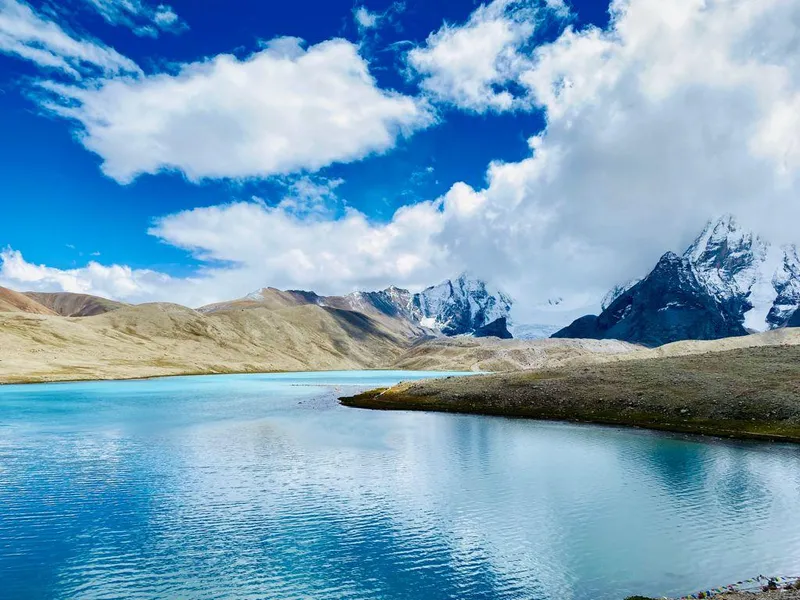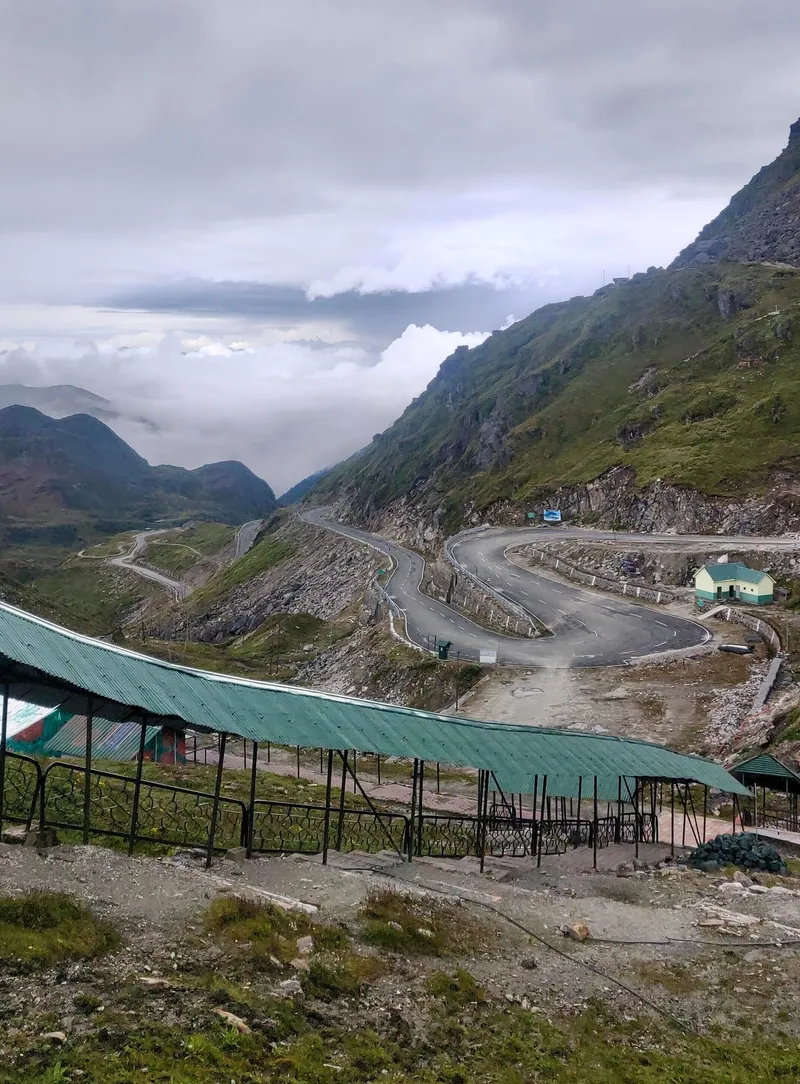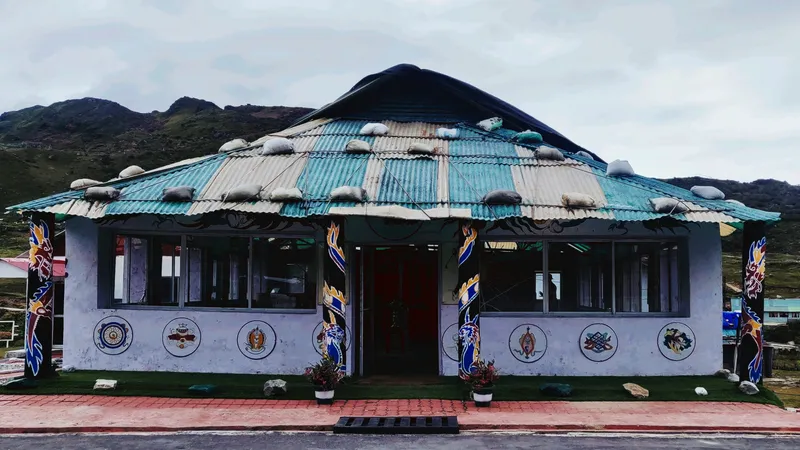Gurudongmar: The Jewel in Sikkim’s Crown
Surrounded by snow-capped mountains and said to be one of the highest lakes in the world, the azure Lake Gurudongmar is a spectacular sight.
The road to nowhere seemed unrelenting, having kept us on the go for what seemed like hours. The terrain grew starker with every passing kilometre, the browns and beiges more reminiscent of Ladakh than the verdant green of Sikkim.
The road had almost disappeared into potholes, and I had just about answered (what seemed like) the thousandth “are we there yet” with (what was) a remarkable amount of patience when the car finally screeched to a halt.
The driver, who made it seem like the protracted journey was all in a day’s work, hid a smile at our woebegone faces and opened the door.
We got out, weary and somnolent. Till the myriad of shades of blue at Gurudongmar woke us up good and proper.
Said to be one of the highest lakes in the world, Lake Gurudongmar is located in the Great Himalayas in the state of Sikkim. Surrounded by snow-capped mountain peaks, including Mt Siniolchu and Mt Khangchendzonga, the azure jewel is stunning and awe-inspiring.

Surrounded by lofty moutains, Gurudongmar Lake is the ultimate gem you could hope to find at the end of a long treasure trail.
The glacier-fed lake, at an altitude of 17,800 feet, is a vision in blue–aqua, cerulean, teal, lapis, sapphire, indigo, cobalt, periwinkle, and sky blue co-exist in a water body that spans 290 acres and routinely mirrors the surrounding mighty mountains and the myriad shades of the sky. The water surface is calm and serene, and influences the bearing of all those who come visiting. There’s no way you can resist the charms of the still and crystal-clear water, the beauteous mountains and rhododendron trees, and the many Tibetan flags fluttering almost everywhere.
There comes a time in a person’s life when she realises that despite possessing the very latest tech, there’s no way a picture can do justice to the splendor of a place. A picture may say a thousand words, but what happens when even thousands of words aren’t enough? For me, Gurudongmar brought that realisation. And after a while, despite bikers around me going click-crazy, I slipped the phone into my pocket and decided to soak in the moment. The here and now.
Local lore has it that the lake is named after Guru Padmasambhava, also known as Guru Rinpoche, who was approached by locals who found themselves struggling for drinking water when the lake waters froze in the winter. The guru placed his hand in one area of the lake, which stopped freezing no matter the temperature.
Another set of believers attribute the name to Sikh Guru Nanak Dev, who is said to have traversed the area in the 15th century. His walking stick and blessings stopped a section of the lake from freezing, and imbued the water with strength and virility.
Since then, the lake is believed to be sacred for Hindus, Sikhs, and Buddhists, and visitors routinely carry back bottled water with them.
However, getting to the lake isn’t for the faint-hearted. It requires planning and needs you to be in the best of physical health. The lake can be reached by road from Lachen via Thangu Valley. It appears to be a short distance away, but in the mountains nothing is like what it seems.

Lachen is about 70 km from Gurudongmar, but the bumpy road means it can take more than three hours to traverse the distance.
Journeying in the mountains
We set out from Lachen, a small town located in Mangan district at an altitude of over 8,000 feet, early in the morning. Apart from being the best base to travel to Gurudongmar, Lachen, which translates to “big pass”, is also the base to the Chopta Valley and home to the Thangu, an annual yak race held here every summer.
Thirty kilometres away lies Thangu Valley, which sits at a majestic elevation of 13,500 feet and is criss-crossed by four rivers–the Teesta, the Lassur, the Chopta, and the Thangu. The valley is also home to the state bird of Sikkim, the Blood Pheasant that shows off bright red feathers at its forehead, throat, and breast.
Thangu Valley is a bird-watcher’s paradise in summers, the chatty driver tells us as we drive up to the Thangu checkpost where olive greens and military men abound.
The checkpost, a restricted area, is the last stop before Gurudongmar, now less than two hours away. At the penultimate point, we decided to stop off at Munres, said to be the world’s highest dosa point for a quick South Indian pick-me-up. Tummies full and BP/oxygen saturation checks done, we drove off for the last leg of the journey.

The heavily-built, long-haired domesticated yak is found throughout the Himalayan region.
And Gurudongmar lived up to every one of the promises people had made. It was stunning, spectacular, and unforgettable. Enough said!
The next day, keen to savour more of Sikkim’s natural riches, we drove off to Tsomgo, also known as Changgu Lake, a glacial water body about 40 km from Gangtok.
The lake, frozen during winter, is known for changing colour with shifting seasons. It was muddy brown when we reached, but the mess owner swore it had been a deep blue just weeks earlier, in July. Decorated yak sat by the lake side, with owners promising gleeful tourists a special souvenir-a picture or a yakback ride!
On to Nathu La
The beauteous road from Tsomgo snakes up higher to Nathu La, a high altitude pass located on the Old Silk Road at the India-China border. The name is traditionally interpreted as the “whistling pass” or the “listening ears pass”.

Situated on the Indo-Tibetan border, Nathu La is one of the most important Himalayan passes.
However, the Chinese version translation of Nathu La is the most poetic: “a place where snow is deepest and the wind strongest”.
The pass, sited at nearly 14,000 feet, offers a breathtaking view of the mountains and the long winding roads that serrate the peaks. If you’re lucky and the mist is out, you may catch a glimpse of Tibet’s Chumbi Valley.
Nathu La, which provides an alternative pilgrimage route to Mount Kailash and Lake Manasarovar, does not have a no-man’s land; only soldiers and barbed wire separate both countries.
After the customary photo, we head off for the Yak Golf Course in Kupup. Nestled amid the Himalayas, rich in gurgling streams and verdant greenery, this is the highest golf course in the world (13,025 feet). The terrain makes the army course challenging as does the unreliable weather, more fickle than a capricious lover. But we tee off – if only for the souvenir photos.
Getting comfortable in bed at Lachen later that night, after pulling off a couple of leeches, no less, I reflect on all the wonders I have seen in the past couple of days. Natural attractions and human fortitude are to be seen at every corner in the Himalayas. But as my eyelids shut out the world, one image creeps unbidden into my mind: the quietude of Gurudongmar.

Located at 13,025 feet above sea level, the Yak Golf Course has been listed as the world's highest golf course by the Guinness Book of World Records.
Tourist Tips
- Plan your trip between June and October as Gurudongmar remains completely frozen in the winter months--from November to Mid-May.
- Indian tourists are allowed to visit the lake, but need to get a permit. Local drivers and store owners can guide you regarding this. No cars are allowed to set off to the lake from Thangu after 11 am as the weather “packs up”. So plan your day accordingly.
- Acclimatisation is important at high altitudes, so make sure you stay a night at Lachen to let your body get used to the height. Don’t run/exert yourself. Seek medical attention immediately, if needed. It is advisable not to stay longer than an hour at Gurudongmar or Nathu La.
- Make sure you carry snacks and water whether you’re doing a day journey or a night halt. You never know when a landslide may keep you cloistered in the car for hours.
Edited by Megha Reddy





![[Startup Bharat] Meet the 3 friends who turned entrepreneurs with a baby apparel company](https://images.yourstory.com/cs/2/b87effd06a6611e9ad333f8a4777438f/beelittle-1644327786164.png?mode=crop&crop=faces&ar=1%3A1&format=auto&w=1920&q=75)

